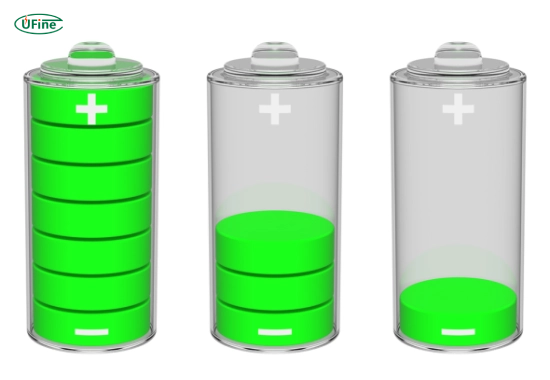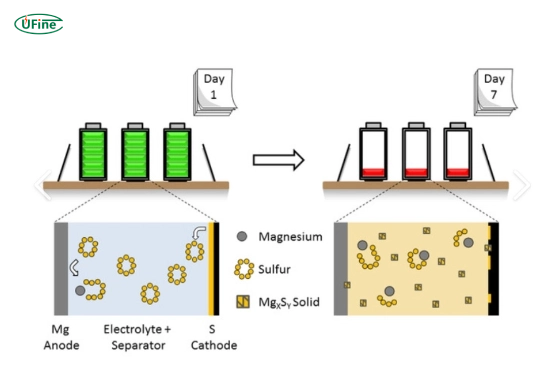Batteries are essential to our daily lives, powering everything from smartphones to electric vehicles. However, many users may need help understanding the implications of leaving a battery uncharged for an extended period. This article delves into the consequences of prolonged inactivity in batteries, mainly focusing on lithium-ion and lead-acid batteries.
Part 1. What happens to a battery when it is left uncharged?
Several processes can lead to degradation when a battery is left uncharged for a long time. The most significant effects are related to the chemical reactions within the battery, which can result in permanent damage.
- Self-discharge: All batteries experience a phenomenon known as self-discharge, where they lose charge even when not in use. This loss is gradual but can lead to significant depletion over time. For example, a fully charged lithium-ion battery can lose about 5-20% of its monthly charge just sitting idle.
- Sulfation: Prolonged disuse can cause sulfation in lead-acid batteries, where lead sulfate crystals form on the battery plates. This process reduces the battery’s capacity and makes it difficult to recharge. Sulfation begins when the battery is discharged below 50% and can become severe if left uncharged for weeks or months.
- Deep discharge: If the charge of lithium-ion batteries drops below a critical level, they enter a state known as deep discharge. This condition can damage the battery’s internal structure and significantly reduce lifespan. A lithium-ion battery you deeply discharge may not recover, even if you recharge it.
Part 2. Why does self-discharge occur?
Self-discharge occurs due to internal chemical reactions, even when the battery remains disconnected from a load.
- Chemical reactions: In lithium-ion batteries, lithium ions migrate between the anode and cathode, causing gradual charge depletion. This movement happens because of slight imbalances in the chemical composition inside the battery.
- Temperature effects: Higher temperatures can accelerate self-discharge rates, leading to faster depletion of stored energy. For instance, storing a battery in a hot environment can double its self-discharge rate compared to more excellent conditions.
Part 3. What is sulfation and how does it affect lead-acid batteries?
Sulfation is a critical issue for lead-acid batteries left uncharged for too long.
- Formation of lead sulfate crystals: When a lead-acid battery discharges deeply and remains in that state, lead sulfate crystals can form on the plates. These crystals are difficult to convert back into active material during charging. As sulfation progresses, it creates barriers that prevent effective charging.
- Reduced capacity: As sulfation continues, the battery’s ability to hold charge diminishes. This leads to shorter usage times and eventual failure. After significant sulfation, a sulfated lead-acid battery may only have 30% of its original capacity.
Part 4. The dangers of deep discharge in lithium-ion batteries
Deep discharge poses severe risks for lithium-ion batteries.
- Irreversible damage: When lithium-ion batteries are discharged below their safe threshold, they may suffer irreversible damage, making it challenging or impossible to recharge them effectively. This damage often manifests as reduced performance and a shorter overall lifespan.
- Crystallization of electrolyte: Deep discharge can cause crystallization within the electrolyte, blocking ion flow and further complicating recharging efforts. This crystallization leads to increased internal resistance within the battery.
Part 5. How long can you leave a battery uncharged?
The duration a battery can remain uncharged without significant damage varies by type:
- Lead-acid batteries: Typically, you should charge these batteries for only a few weeks without causing sulfation. If you know you won’t use your vehicle for an extended period, it’s wise to disconnect or charge the battery regularly.
- Lithium-ion batteries: These can usually withstand several months of inactivity but will begin to show signs of damage if left uncharged beyond this period. If you don’t use them for an extended time, store them at around 40% charge.
Part 6. Signs your battery may be dying
Recognizing early signs of battery failure can help prevent complete loss:
- Decreased performance: Devices powered by the battery may exhibit reduced performance or longer charging times. Your smartphone takes longer to charge fully or drains faster than usual.
- Swelling or leakage: Physical changes such as swelling or leakage indicate that a battery is failing, and you should replace it immediately. If you see any bulging or liquid seeping from your device’s battery compartment, stop using it immediately.
Part 7. Best practices for maintaining battery health
To prolong the lifespan of your batteries and avoid issues related to prolonged inactivity:
- Regular charging: Keep your batteries charged regularly, mainly if used sparingly. Aim to recharge them every few months if they sit idle for long periods.
- Proper storage conditions: Store batteries in cool, dry places at optimal temperatures (typically around 15°C or 59°F) to minimize self-discharge rates. Avoid leaving them in hot cars or damp areas where moisture could seep in.
Part 8. Can you revive a dead battery?
Reviving a seemingly dead battery depends on its condition:
- Lead-acid batteries: In some cases, desulfation chargers can help revive slightly sulfated lead-acid batteries by reversing some damage caused by sulfation. However, this method is only sometimes successful and depends on how long the battery has been inactive.
- Lithium-ion batteries: If deeply discharged, these batteries may not recover; however, some chargers designed for low-voltage recovery might help if the damage is not severe. Always check manufacturer guidelines before attempting recovery methods.
Lithium Battery Not Charging and How to Solve it?
Part 9. FAQs
-
What should I do if my car battery dies?
If your car battery dies, try jump-starting it using jumper cables and another vehicle’s power source. If it doesn’t hold a charge afterward or shows signs of swelling or leakage, consider replacing it or having it tested by a professional mechanic. -
How often should I charge my lithium-ion battery?
To maintain your lithium-ion battery’s health and longevity, charge it regularly and avoid letting it drop below 20% charge whenever possible. -
Is it safe to leave my device plugged in all the time?
While many modern devices have built-in protections against overcharging, it is still advisable to unplug them once fully charged to prevent heat buildup and potential long-term damage. -
Can extreme temperatures affect my battery life?
Yes! Extreme heat can accelerate self-discharge and increase battery wear, while cold temperatures may temporarily reduce performance and are generally less harmful than heat exposure over time. -
How do I know if my battery needs replacing?
If you notice decreased performance from your device powered by the battery, physical swelling or leakage from the casing, or if your device fails to hold a charge after several attempts at recharging it fully, it’s time for a replacement.
Related Tags:
More Articles

How to Choose the Best Floor Scrubber Battery for Commercial Cleaning?
Selecting the ideal floor scrubber battery ensures a long runtime, rapid charging, and minimal maintenance for efficient commercial cleaning operations.
Battery for Blower vs Battery for Leaf Vacuum: Which One Should You Choose?
Battery for blower vs leaf vacuum—learn the key differences in power, fit, and runtime to choose the right battery for your outdoor tool needs.
How to Choose the Right Battery for Blower?
Choosing the right blower battery? Consider voltage, capacity, chemistry & usage. This guide helps match the best battery for peak performance.
How to Choose the Best Insulated Battery Box for Lithium Batteries?
Choosing the Best Insulated Battery Box for Lithium Batteries? Discover key factors such as size, material, and safety for optimal protection and performance.
7 Critical Elements on a Lithium Battery Shipping Label
What must be on a lithium battery shipping label? Learn 7 key elements to ensure safety, legal compliance, and correct handling across all transport modes.





